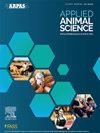Effects of low temperature and ensiling time on fermentation and nutritive value of sorghum- sudangrass silage
IF 1.5
Q3 AGRICULTURE, DAIRY & ANIMAL SCIENCE
引用次数: 0
Abstract
Objective
The study evaluated the fermentation and nutritive value of freeze-affected sorghum-sudangrass si- lage stored at 2 temperatures.
Materials and Methods
Sorghum-sudangrass for- age affected by several frost/freeze events and lodging was harvested and chopped, then ensiled in vacuum-sealed plastic mini-silos. Silos were stored at either 4°C or 20°C for 5, 10, 15, 30, or 60 d with triplicate silos at each time. Resulting silage was evaluated for pH, silage acids and al- cohols, nitrates, and nutritive value. Aerobic stability was also measured on silages stored for 60 d.
Results and Discussion
Silage pH decreased more quickly at 20°C, with silage at 4°C having a 10-d lag be- fore pH decreased. Lactic, acetic, and propionic acid con- centrations were greater at all times for silage stored at 20°C. Ethanol and methanol were greater in silage stored at 20°C, which is speculated to be from increased yeast activity. The decreased fermentation for silage stored at 4°C resulted in 1% greater DM recovery; however, aerobic stability was better for silage stored at 20°C (149 h) than 4°C (47 h) likely due to greater acetic acid concentration. Silage storage at 4°C resulted in lower NDF concentration due to less silage acid production, with no other changes in nutritive value observed due to storage temperature. Nitrate concentrations were low in the initial forage (76 mg/kg DM) with concentrations lower after storage (43– 50 mg/kg DM), as expected.
Implications and Applications
Storage temperature of sorghum-sudangrass silage had a significant impact on silage acid production and aerobic stability with limited fermentation the first 10 to 15 d of storage. This research is applicable when harvesting forage during cold or freez- ing temperatures, which limits early fermentation. Allow- ing standing forage to thaw/warm before harvest may improve fermentation and aerobic stability. Additional research on changes in nitrates of frosted sorghum forage is needed to confirm results in forage with high initial nitrate levels.
低温和青贮时间对高粱-苏丹草青贮发酵及营养价值的影响
目的研究冻害高粱苏丹草在2种温度下的发酵及营养价值。材料与方法对受冻害和倒伏影响的高粱苏丹草进行采收和切碎,然后在真空密封的塑料小筒仓中青贮。筒仓在4°C或20°C下保存5、10、15、30或60 d,每次保存三个筒仓。对所得青贮料的pH值、青贮酸、醇、硝酸盐和营养价值进行了评价。结果和讨论青贮在20°C时pH值下降得更快,在4°C时青贮在pH值下降之前有10天的滞后。乳酸、乙酸和丙酸浓度在贮藏于20°C的青贮饲料中始终较高。乙醇和甲醇在贮藏于20℃的青贮饲料中含量较高,推测这是由于酵母活性增加所致。4℃贮藏青贮发酵减少,DM回收率提高1%;然而,在20°C (149 h)下贮藏的青贮料的有氧稳定性比在4°C (47 h)下贮藏的青贮料更好,这可能是由于乙酸浓度更高。青贮在4°C下储存,由于青贮酸产量减少,NDF浓度降低,其他营养价值未因储存温度而发生变化。初采饲料中硝酸盐浓度较低(76 mg/kg DM),贮藏后浓度较低(43 ~ 50 mg/kg DM)。高粱-苏丹草青贮的贮藏温度在贮藏前10 ~ 15 d对青贮的产酸量和有氧稳定性有显著影响。这项研究适用于在寒冷或冰冻温度下收获牧草,这限制了早期发酵。在收获前,将草料解冻/加热可以改善发酵和有氧稳定性。需要进一步研究霜高粱草料中硝酸盐的变化,以确认高初始硝酸盐水平草料的结果。
本文章由计算机程序翻译,如有差异,请以英文原文为准。
求助全文
约1分钟内获得全文
求助全文

 求助内容:
求助内容: 应助结果提醒方式:
应助结果提醒方式:


